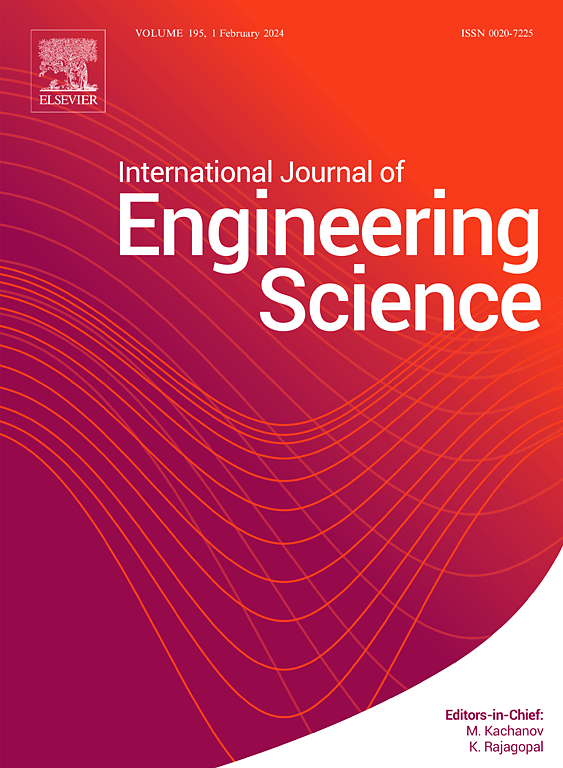层合橡胶支座在剧烈压缩和侧向变形下的整体和局部竖向刚度
IF 5.7
1区 工程技术
Q1 ENGINEERING, MULTIDISCIPLINARY
International Journal of Engineering Science
Pub Date : 2025-07-24
DOI:10.1016/j.ijengsci.2025.104357
引用次数: 0
摘要
以往的研究主要是评估叠合橡胶支座的整体竖向刚度(Kv),通常将总竖向变形视为单个橡胶层的总和。纯压缩时,最大变形发生在顶层。但在轴向压力和侧向变形联合作用下,变形分布发生偏移,最大变形位置随侧向位移的大小而变化。因此,评估每个橡胶层的局部Kv对于准确捕获力学行为至关重要。通过逐层分析,可以确定在不同横向位移下变形最大的层,从而确定最小的局部Kv。通过将Mullins效应和prony系列粘弹性纳入到Yeoh超弹性模型中,有限元模拟得到了显著改进,从而捕获了全加载和卸载行为,与实验数据具有很强的一致性。考虑到第一和第二形状因子(S₁和S₂)的变化以及不同的轴向压力水平(P、2P和3P),本研究对橡胶轴承的整体和局部Kv进行了全面调查,其中P表示设计压力。结果表明,随着S₂的增加,总Kv值增大,但局部Kv值的下降更为严重。相反,较高的S₁值提高了轴承稳定性,降低了局部Kv相对于全局Kv的灵敏度。随着轴向压力的增加,低S₁和高S₂的轴承刚度降低幅度更大,而高S₁值则会缓解这种影响。最后,提出了归一化全局和局部刚度的经验公式,与有限元和实验结果均具有良好的相关性。本文章由计算机程序翻译,如有差异,请以英文原文为准。
Global and local vertical stiffness of laminated rubber bearings under severe compression and lateral deformation
Previous studies mainly evaluated the global vertical stiffness (Kv) of laminated rubber bearings, typically considering the total vertical deformation as the sum of individual rubber layers. Under pure compression, maximum deformation occurs in the top layer. However, under combined axial pressure and lateral deformation, deformation distribution shifts, with the location of maximum deformation varying with lateral displacement magnitude among the rubber layers. Thus, evaluating the local Kv of each rubber layer is essential to accurately capture mechanical behavior. A layer-by-layer analysis identifies the most deformed layer under different lateral displacements, enabling determination of the minimum local Kv. Finite element simulations are significantly improved by incorporating the Mullins effect and Prony-series viscoelasticity into the Yeoh hyperelastic model, thereby capturing the full loading and unloading behavior and achieving strong agreement with experimental data. This study presents a comprehensive investigation into both the global and local Kv of rubber bearings, considering variations in the first and second shape factors (S₁ and S₂) and different axial pressure levels (P, 2P, and 3P), where P denotes the design pressure. The results indicate that increasing S₂ enhances global Kv but also leads to more severe degradation in local Kv. In contrast, higher S₁ values improve bearing stability and reduce the sensitivity of local Kv relative to global Kv. Bearings with low S₁ and high S₂ exhibit greater stiffness reduction under increasing axial pressure, while higher S₁ values mitigate this effect. Finally, empirical formulations for normalized global and local stiffness are proposed, showing good correlation with both finite element and experimental results.
求助全文
通过发布文献求助,成功后即可免费获取论文全文。
去求助
来源期刊

International Journal of Engineering Science
工程技术-工程:综合
CiteScore
11.80
自引率
16.70%
发文量
86
审稿时长
45 days
期刊介绍:
The International Journal of Engineering Science is not limited to a specific aspect of science and engineering but is instead devoted to a wide range of subfields in the engineering sciences. While it encourages a broad spectrum of contribution in the engineering sciences, its core interest lies in issues concerning material modeling and response. Articles of interdisciplinary nature are particularly welcome.
The primary goal of the new editors is to maintain high quality of publications. There will be a commitment to expediting the time taken for the publication of the papers. The articles that are sent for reviews will have names of the authors deleted with a view towards enhancing the objectivity and fairness of the review process.
Articles that are devoted to the purely mathematical aspects without a discussion of the physical implications of the results or the consideration of specific examples are discouraged. Articles concerning material science should not be limited merely to a description and recording of observations but should contain theoretical or quantitative discussion of the results.
 求助内容:
求助内容: 应助结果提醒方式:
应助结果提醒方式:


